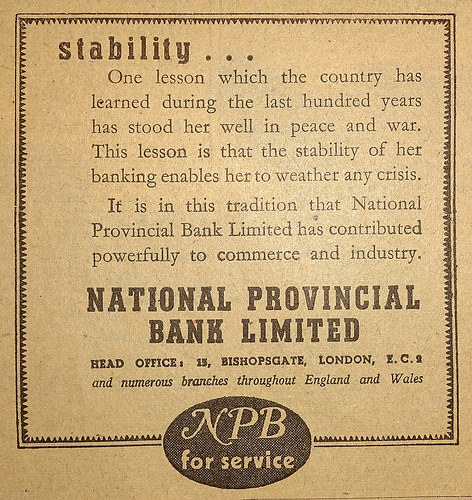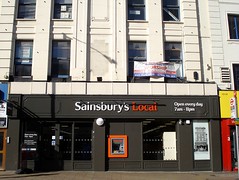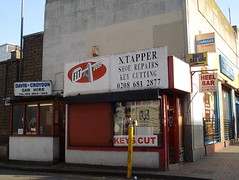The breezeblock building of West Croydon Station's London Road entrance also houses a branch of Greggs, the UK-wide bakery and pasty-seller. I suspect most of their custom comes from people passing through the station, helped by the fact that the shop has a second entrance leading directly into the ticket hall. Certainly my own main reason for visiting this Greggs has been to grab something quickly to eat on the train.
The building was constructed in the early 1930s, as part of the redevelopment of West Croydon Station[1]. One of the first businesses to move into the premises was a branch of the National Provincial Bank[2], a predecessor of today’s NatWest Bank.

While today the premises at 10 London Road have just one occupant, it appears that when it was originally constructed there was more than one business operating from the same address[3]. Ward’s street directory for 1934 lists both “Anne, Millinery” and “Nat Prov Bk Ltd” at number 10[4], though by 1937 Anne had moved out and been replaced by “H Purchen, Jeweller”.
H Purchen remained alongside the National Provincial Bank at 10 London Road until the mid-1950s[5], then moved to 88 Church Street[6]. However, by 1967 it had returned to West Croydon, moving back to the same block a few doors down on the other side of the station entrance, at 168 North End. It’s still at 168 North End today, though Mr Purchen is deceased and the business is now more focused on pawnbroking[7].
Around the time that H Purchen moved out of 10 London Road, the National Provincial Bank took action to expand its premises into the vacated space. In October 1957, it was granted planning permission for “Alterations to form extension to Bank premises”. A diagram included in the planning application shows “public space” to the left of the premises and “B.O. and M/C Area” to the right, directly abutting the entrance to West Croydon Station[8].
In 1968, the National Provincial Bank (and its subsidiary District Bank) announced its intention to merge with Westminster Bank. The combined company began to trade as the National Westminster Bank from 1 January 1970, and later that year the branch at 10 London Road was rebranded as National Westminster[9].
A planning application from late 1970 includes correspondence from Pearce Signs Limited in connection with a somewhat involved discussion about what sort of external advertising would be considered suitable. Pearce Signs seem to have been pushing for an additional sign on the north-facing side of the building, around the corner from London Road itself[10]. This suggests that prospective bank customers may have been approaching from the north, along London Road — in contrast to the current situation, where one of the main concerns of the London Road traders is to attract customers from the main centre of town, to the south.
The West Croydon branch of the National Westminster Bank closed on 18 October 1974[11], though there’s evidence that the company may have continued to own the building for some years following[12]. In early 1975, “S P Sports trading as Ladbrokes” put in a planning application for installation of a new shopfront in connection with a change of use to a licenced betting office. However, this never went ahead as they were refused a betting office licence and hence withdrew their planning application[13].
The next occupant of the premises[14] was thus not a betting office but an off licence. On 25 May 1976, Oddbins (UK) Ltd[15] was granted planning permission for the erection of three illuminated fascia signs and a non-illuminated projecting sign. A sketch plan accompanying this application shows a central door flanked by two large windows, and the name ODDBINS in triplicate across the top[16].
Oddbins remained at the premises until around the mid-to-late ’80s. There’s evidence of a brief appearance by another off licence called Gough Bros, probably around 1987, but by 1988 the premises was in the hands of Threshers[17].
Threshers seems to have made a few internal changes as well as the shopfront changes required to add its branding, but I’ve been unable to view the details of these; the planning applications come under “buildings” and are not in the public domain. Threshers remained at the premises until the mid-to-late 1990s[18].
Greggs submitted its first planning application for 10 London Road in late 1998. A drawing dated October 1998 shows a ground floor plan that looks very similar to the current configuration, and a long list of “proposed shopfitting works” includes lots of “stripping out” and removal of “existing loose rubbish”. I don’t know when these extensive works were completed, but Greggs was certainly established in the property within the next couple of years, as the second edition of the Shop ’Til You Drop guide (probably published around the start of 2002[19]) lists it at that address.
Croydon now has two other branches of Greggs, one on Wellesley Road and one on the High Street; there's also one in nearby Addiscombe. The official closing time of the London Road branch is 6:30pm, although they sometimes seem to stay open a bit later to sell the last of their stock.
Greggs specialise in sandwiches, sweet and savoury British pastries, and cakes. Their prices are low, but I find their pasties and sausage rolls at least are not of particularly high quality. Their sandwiches and filled rolls are a better bet; whenever I've bought one, the salad has been fresh and crisp and the fillings adequate. I’m a particular fan of the tuna crunch bloomer, which is pepped up with a relish described on the wrapper as “red pepper salsa”.
Thanks to: the RBS Archives team; Paul Manly at Whittalls Wine Merchants; Brian Gittings; John Clarke; Colin Withey; the Planning Technical Support Team at Croydon Council; all at the Croydon Local Studies Library; and my beta-readers Antonia, David, Flash, Kat, and Kerry.
Footnotes and references
- The 1930s redevelopment of West Croydon Station is described at greater length in a previous article in this series. There was an earlier building, demolished as part of said redevelopment, that was briefly numbered 10 London Road; Ward’s street directories for 1928, 1929, and 1930 list Halford Cycle Co Ltd at 8–10 London Road (previously 4–5 Station Parade). Halfords seem to have moved up the road to numbers 40–42 (to be discussed later in this series), and Ward’s directories list them at that address from 1932.
- According to the RBS Archives team, the National Provincial Bank at 10 London Road was known as the Croydon West branch, and it opened on 1 July 1933 as a sub-office to the main Croydon branch.
- The choice to number both premises as 10 is a little confusing, given that numbers 2–8 don’t exist so I see no reason why they couldn’t have numbered one as 8 and the other as 10. Perhaps this is further evidence that (as I speculate in footnote [5]), H Purchen didn’t have an entrance actually on London Road.
- It also lists Finlay & Co, tobacconists, but I’m pretty sure this was actually in the kiosk around the side of the building — more on this next time.
- H Purchen is listed at 10 London Road in Kent’s street directories for 1955 and 1956. A photograph dated 24 January 1954 at Croydon Local Studies Library (ref PH-01-3510-1) shows part of the shopfront of number 10, including a large clock with “H Purchen, Watchmaker & Jeweller” printed around it, though what looks like a door next to it has a National Provincial Bank sign hanging above. This suggests that either the two businesses shared an entrance, or H Purchen was accessed via the station ticket hall.
- The Croydon Local Studies Library has in their “firms” filing cabinet a photocopy of an advert for H Purchen, Watchmaker and Jeweller, at 88 Church Street, Croydon, and 91 St John’s Road, Clapham Junction SW11. No date is given in the original, but an unknown hand has written “1957” on the copy. Kent’s street directory for 1956 lists a different business at 88 Church Street (F Coldrey & Son, bakers and confectioners), suggesting this was a straight move rather than an overlap of different branches.
- The 1967 Croydon Classified Directory (published by H W H Publishing Company, Croydon) lists “Harry Purchen” (under “Jewellers & Watchmakers”) at 168 North End. Blair’s Croydon directory (undated but a handwritten note inside suggests 1969) lists Harry Purchen, jeweller, at 168 North End and 88 Church Street. This could imply an overlap between the two addresses, but I think it’s more likely that the data collection period was an extended one and Harry Purchen moved premises during this time. When I went to the North End premises in November 2012 to ask about the history of the company, the staff told me that they didn’t know anything personally, that Mr Purchen was dead, and that the current owner (who bought the business in the late 1990s) was unlikely to want to talk to me.
- Planning application consulted on microfiche at the Croydon Council offices (ref 57/1337). I think “B.O.” is probably “back office”, but I don’t know what “M/C Area” is. A photograph (ref PH/01 3510B) in the Croydon Local Studies Library, dated 14 May 1958, shows that by that point all signs of H Purchen had been eradicated from this part of the frontage. (Incidentally, this photo is the one used in Eleanor McMillan's 'Then And Now' photo of West Croydon Station.) The result of this expansion can also be seen on Ordnance Survey maps at 1:1250 scale; the 1955 map shows two number 10s, and only the northmost one is marked “Bank”, while the 1970 map shows number 10 as a single property (still marked “Bank”).
- Names and dates relating to the merger were provided by the RBS Archives team; further information on this can be found at the NatWest Group Heritage Hub. Evidence for the London Road rebranding comes from a planning application (ref A5867) which includes a letter dated 13 October 1970 referencing the National Westminster Bank at 10 London Road. In addition, the 1971 Croydon Classified Directory lists National Westminster Bank Ltd at this address.
- Planning application ref A5867. The latter from Pearce Signs is dated 13 October 1970. There’s also a reply from the Borough Engineer, dated 23 October 1970, stating that “I think it most unlikely that my Committee would be prepared to consider any form of advertisement on the flank wall of this property.”
- Date of bank closure provided by the RBS Archives team.
- Evidence around ownership of the building is conflicting and inconclusive. A planning application deposited on 27 April 1976 (ref 76/20/686) states that the owner is British Rail. However, a later application granted on 22 December 1998 (ref 98/2501/A) lists the landlord as National West Group Properties, Turnpike House, 123 High Street, Crawley. Another application received on 2 October 2011 (ref 01/2761/A) records National Westminster Bank Plc as an interested party, but fails to explain the nature of this interest. The RBS Archives team are unsure about the current ownership of the building, but they note that “the address is still in our building locator which may indicate that NatWest still owns, leases or occupies part of the building.”
- Planning application ref 75/20/581. This includes a written note: “Phoned applicant 29/4/75 the Betting Office Licence was refused. ∴ [therefore] Application is to be withdrawn”.
- Planning application 76/20/686 (date deposited 24 April 1976) from Oddbins (UK) Ltd describes the building as “former Bank premises” and states it is currently vacant.
- The current incarnation of Oddbins is not the same as the historical one. Oddbins Ltd went into administration in 2011, and the brand name and some of the shop premises were purchased by Whittalls Wine Merchants. (This information provided by the Head of Operations at Whittalls, who also tells me that sadly they have no records dating back to the 1980s Oddbins and hence are unable to confirm opening and closing dates of the store at 10 London Road.)
- This has some resonance with the current Greggs shopfront, which still has the look of a tri-section frontage despite having the door on the right-hand side instead of in the centre. (I suspect the current door placement is aimed at guiding efficient queue formation.)
- The London Shop Surveys of 1984-85 and 1986-87 list Oddbins at 10 London Road, while the London Shop Surveys 1988-89 lists Gough Bros. I know almost nothing about Gough Bros, though various web searches suggest that it was a chain rather than an independent. A planning application deposited on 19 April 1988 (ref: 88/1316/A) shows a drawing for a proposed shopfront with Threshers signs.
- An article in the Croydon Advertiser of 17 March 1995 (p3) mentions a Threshers near West Croydon Station. No address is given but it seems likely that this refers to the branch at 10 London Road. A planning application from Greggs (ref: 98/2502/P, for shopfront and roller shutter installation, granted on 22 December 1998) states that the previous use of the premises was as a retail wine merchant, though it doesn’t give a name for this merchant, and it states “dates not known”.
- The Shop ‘Til You Drop guides were published by Burrows Communications. No dates are given inside, but the second edition has a Local Studies Library acquisition date of February 2002.

